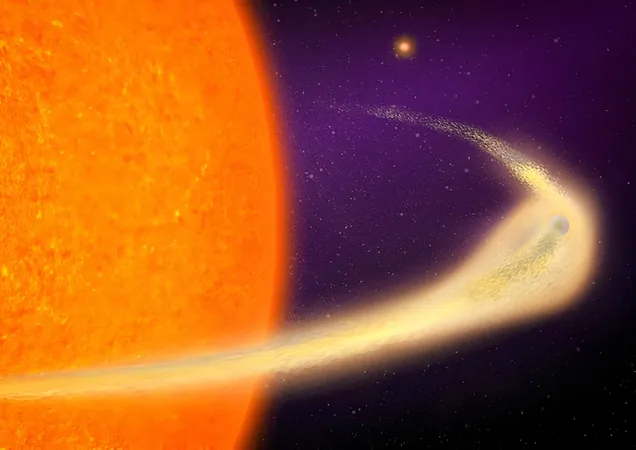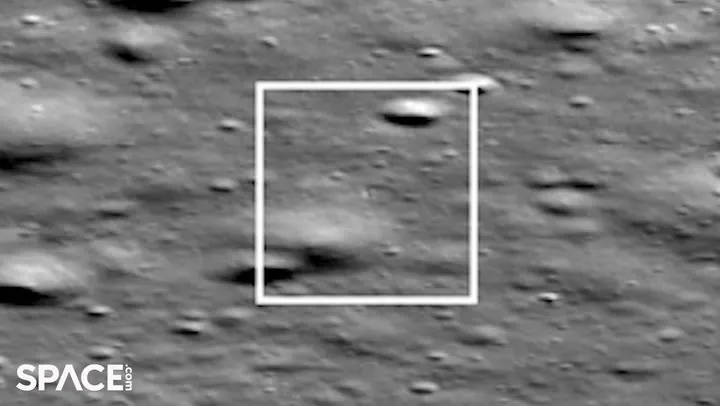
A Dying Exoplanet: The Dramatic Disintegration of BD+05 4868 Ab
2025-04-26
Author: Emma
Far beyond our solar system, approximately 140 light-years away, a fascinating yet alarming cosmic phenomenon is unfolding. An exoplanet named BD+05 4868 Ab is rapidly disintegrating, shedding dust and debris in an extraordinary spectacle.
A Glimpse into Cosmic Catastrophe
NASA's Transiting Exoplanet Survey Satellite (TESS) detected unusual dips in the brightness of the host star—a red flag indicating that something dramatic was underway. Upon closer inspection, astronomers observed this minuscule exoplanet flinging off dust each time it orbits its burning star.
A Tail Waggling with Destruction
Dr. Marc Hon from MIT described the chaotic scene: "The extent of the tail is gargantuan, stretching up to 9 million kilometers (5.6 million miles) long." This planet, orbiting its star every 30 hours, endures scorching temperatures that can melt rock, causing it to shed its outer layers. As a result, it resembles a dusty comet, changing its appearance with each orbit.
The Planet is Losing Mass: A Mountain with Every Orbit
Unlike larger rocky planets that retain their minerals, BD+05 4868 Ab loses mass with every orbit—like a mountain being eroded away. Scientists estimate that if this continues, the planet may face complete obliteration in a few million years.
Avi Shporer from the TESS Science Office emphasized the significance of this observation: "We got lucky with catching it exactly when it’s really going away,” underscoring the rare opportunity scientists have to study such extreme conditions.
The Dust Trail: An Astronomical Mystery
Astronomers primarily observe this planet’s dusty disintegration through transits—when it passes in front of its star. Unique dust clouds create varying brightness patterns of the star, allowing researchers to infer the makeup of the escaping debris.
The formation of this tail of dust suggests that the planet's surface minerals are constantly boiling off, presenting a stark contrast to the more stable conditions typically observed in orbital bodies.
Understanding Planetary Demise: A Rare Instance
Only a handful of exoplanets show signs of such disintegration, providing telescopic insights into the diverse environments of the cosmos. Since the discovery of the first exoplanet in 1992, thousands have been cataloged, revealing a stunning variety of planetary characteristics and fates.
BD+05 4868 Ab stands out as it orbits a particularly bright star, granting clearer observations and potentially richer data on the composition of its dust trail.
Looking to the Future: New Frontiers in Research
Future research will leverage the James Webb Space Telescope’s capabilities to analyze the infrared signatures of dust around BD+05 4868 Ab. These insights could illuminate the mineral composition of distant rocky planets, possibly revealing patterns that resonate with our own solar system.
Although BD+05 4868 Ab is facing its demise, the insights garnered from its dramatic transformation will enrich our understanding of planetary evolution, survival, and the lethal nature of certain celestial orbits.









 Brasil (PT)
Brasil (PT)
 Canada (EN)
Canada (EN)
 Chile (ES)
Chile (ES)
 Česko (CS)
Česko (CS)
 대한민국 (KO)
대한민국 (KO)
 España (ES)
España (ES)
 France (FR)
France (FR)
 Hong Kong (EN)
Hong Kong (EN)
 Italia (IT)
Italia (IT)
 日本 (JA)
日本 (JA)
 Magyarország (HU)
Magyarország (HU)
 Norge (NO)
Norge (NO)
 Polska (PL)
Polska (PL)
 Schweiz (DE)
Schweiz (DE)
 Singapore (EN)
Singapore (EN)
 Sverige (SV)
Sverige (SV)
 Suomi (FI)
Suomi (FI)
 Türkiye (TR)
Türkiye (TR)
 الإمارات العربية المتحدة (AR)
الإمارات العربية المتحدة (AR)